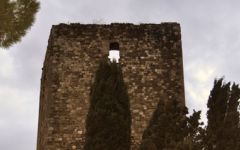Sesti Brunello di Montalcino 2012



Product Details
Your Rating
Somm Note
Winemaker Notes
Brunello is made from 100% sangiovese grapes, which come from the estate vines planted from cuttings taken from very old neighboring vineyards. To fertilise the vineyards and olive groves only vegetable and animal manure are used, and also for the spraying, biodegradable produce are used. After the fermentation the wine is transferred to medium size oak barrels, where it remains for four years before being refined in the bottle for another year, when it is ready to be sold under the denomination DOCG (Denorninazione di origine controllata e garantita) a title which only few wines in Italy can boast.
Other Vintages
2017-
Wine &
Spirits -
James
Suckling -
Robert
Parker -
Wine
Enthusiast
-
Wine
Enthusiast -
James
Suckling -
Robert
Parker
-
James
Suckling -
Robert
Parker -
Wine
Enthusiast
-
Wine
Enthusiast
-
Wine
Enthusiast -
Robert
Parker




While helping out at neighboring estates Giugi observed that simplicity and careful attention were the most important factors in producing great wines, while chemical intervention skewed their delicate balance; so he determined to make entirely natural wines right from the start. He even took a pioneering extra step by applying his prodigious knowledge of the moon’s influence on living things to his vineyard management and winemaking. Today the family continues this thoroughly eco-friendly philosophy (although no official certification currently meets their personal standards), and Elisa’s primary concern is the materia prima, or raw material, that goes into the wine. The Sesti lineup includes a white Sauvignon and a Sangiovese Rosato born directly of necessity, since the family wanted something light and cooling to drink under the hot summer sun; they were forced to increase production when visiting friends and clients tried these wines and started placing orders. But their basic trio—the Brunello, Brunello Riserva “Phenomena,” and Rosso di Montalcino—provides traditional expressions of the appellation, robust and powerful yet refreshing, with great aging potential in the Brunellos.

Among Italy's elite red grape varieties, Sangiovese has the perfect intersection of bright red fruit and savory earthiness and is responsible for the best red wines of Tuscany. While it is best known as the chief component of Chianti, it is also the main grape in Vino Nobile di Montepulciano and reaches the height of its power and intensity in the complex, long-lived Brunello di Montalcino. Somm Secret—Sangiovese doubles under the alias, Nielluccio, on the French island of Corsica where it produces distinctly floral and refreshing reds and rosés.

Famous for its bold, layered and long-lived red, Brunello di Montalcino, the town of Montalcino is about 70 miles south of Florence, and has a warmer and drier climate than that of its neighbor, Chianti. The Sangiovese grape is king here, as it is in Chianti, but Montalcino has its own clone called Brunello.
The Brunello vineyards of Montalcino blanket the rolling hills surrounding the village and fan out at various elevations, creating the potential for Brunello wines expressing different styles. From the valleys, where deeper deposits of clay are found, come wines typically bolder, more concentrated and rich in opulent black fruit. The hillside vineyards produce wines more concentrated in red fruits and floral aromas; these sites reach up to over 1,600 feet and have shallow soils of rocks and shale.
Brunello di Montalcino by law must be aged a minimum of four years, including two years in barrel before realease and once released, typically needs more time in bottle for its drinking potential to be fully reached. The good news is that Montalcino makes a “baby brother” version. The wines called Rosso di Montalcino are often made from younger vines, aged for about a year before release, offer extraordinary values and are ready to drink young.
